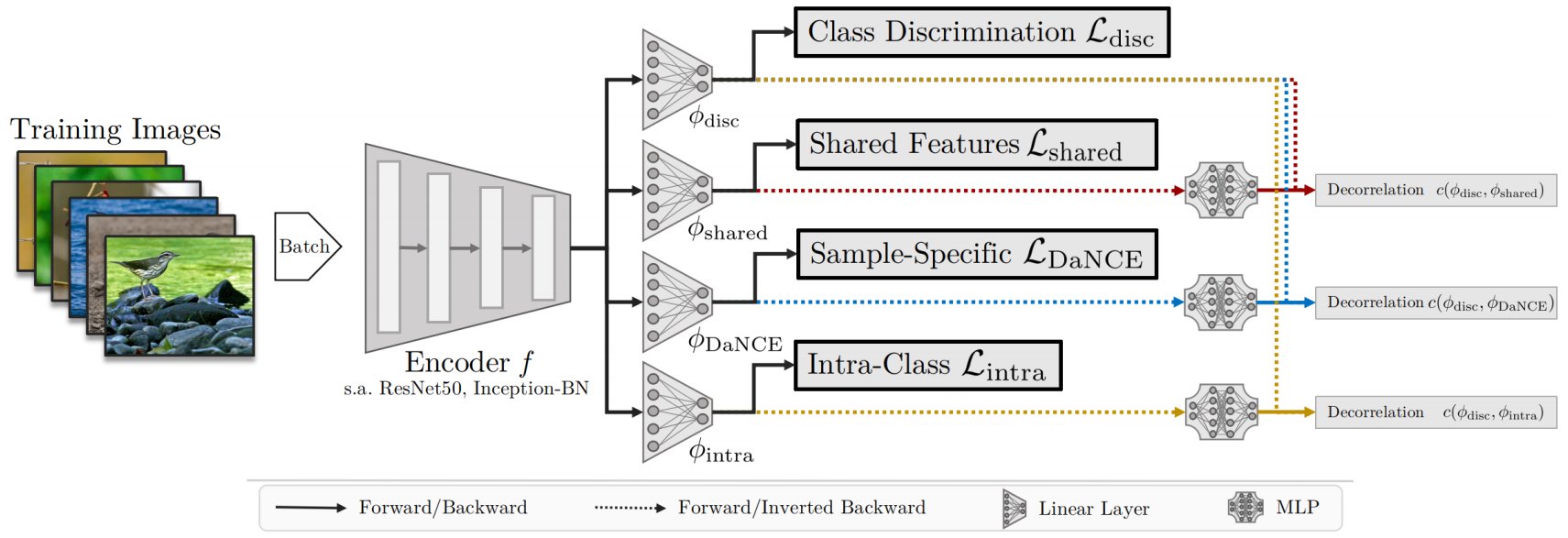This repository contains implementations for
DiVA: Diverse Visual Feature Aggregation for Deep Metric Learning
accepted to ECCV 2020.
Link: https://arxiv.org/abs/2004.13458
The majority of this codebase is built upon research and implementations provided in Paper: https://arxiv.org/abs/2002.08473 Repo: https://github.com/Confusezius/Revisiting_Deep_Metric_Learning_PyTorch
This repository contains the DiVA extension to standard Deep Metric Learning by extending auxiliary and self-supervised features for improved generalization to unseen test classes:
Contact: Karsten Roth, karsten.rh1@gmail.com
Suggestions are always welcome!
Architecturally, running DiVA extends DML like this:

If you use this code in your research, please cite
@misc{milbich2020diva,
title={DiVA: Diverse Visual Feature Aggregation for Deep Metric Learning},
author={Timo Milbich and Karsten Roth and Homanga Bharadhwaj and Samarth Sinha and Yoshua Bengio and Björn Ommer and Joseph Paul Cohen},
year={2020},
eprint={2004.13458},
archivePrefix={arXiv},
primaryClass={cs.CV}
}
- PyTorch 1.2.0+ & Faiss-Gpu
- Python 3.6+
- pretrainedmodels, torchvision 0.3.0+
for a detailed installation script and download links to all benchmarks, please visit https://github.com/Confusezius/Revisiting_Deep_Metric_Learning_PyTorch
Update 14/09/21: There was a slight error in the uploaded fast_moco.py script resulting in negative reweighting different to that mentioned in the paper. As such, we have introduced the --diva_fixed-flag which can be used to run the corrected fast momentum contrast/nce objective. Performance however remains effectively the same, so it is not necessarily needed. Thanks to BrandonHanx for noticing!
Training is done by using diva_main.py, with settings available in parameters.py. Exemplary runs are provided in SampleRuns/ECCV2020_DiVA_SampleRuns.sh.
Logging via Weights and Biases follows the same setup as in https://github.com/Confusezius/Revisiting_Deep_Metric_Learning_PyTorch.
Generally, a run can look like this:
python diva_main.py --dataset cub200 --log_online --project DiVA_SampleRuns --group CUB_DiVA-R50-512
--diva_ssl fast_moco --source_path $datapath --tau 55 --gamma 0.2
--diva_alpha_ssl 0.3 --diva_alpha_shared 0.3 --diva_alpha_intra 0.3
--diva_rho_decorrelation 1500 1500 1500 --diva_features discriminative selfsimilarity shared intra
--diva_sharing random --evaltypes all --diva_moco_temperature 0.01 --diva_moco_n_key_batches 30
--n_epochs 350 --seed 0 --gpu 0 --samples_per_class 2
--loss margin --batch_mining distance --arch resnet50_frozen_normalize
--embed_dim 128 (--diva_fixed)
We apply DiVA on CUB (--dataset cub200) and Margin Loss (--loss margin) with distance-based batchmining (--batch_mining distance).
We use the standard discriminative features, as well as self-supervised features selfsimilarity based on "fast Momentum Contrast" (--diva_ssl fast_moco), corresponding to the DaNCE objective in the original paper, as well as shared and intra_class features (intra), all of which we note in --diva_features discriminative selfsimilarity shared intra.
Each auxiliary loss is weighted by 0.3 (see --diva_alpha_ssl, --diva_alpha_shared, --diva_alpha_intra). Each decorrelation (discriminative to ...) is weighted by 1500 (see --diva_rho_decorrelation). Finally, some self-supervision/MoCo specific hyperparameters (--diva_moco_temperature, --diva_moco_n_key_batches), corresponding to the temperature and number of key batches used in the NCE objective.
Finally, each embedding space has dimensionality --embed_dim 128, meaning that during testing, we evaluate on a ResNet50 with a total dimensionality of 4 x 128 = 512.
We also note that other self-supervision methods can be included as well (see criteria/__init__.py and parameters.py), e.g. Deep Clustering:
python diva_main.py --source_path $datapath --log_online --project DiVA_Experiments --diva_rho_decorrelation 500
--diva_features discriminative dc --evaltypes all --diva_dc_update_f 2 --diva_dc_ncluster 300
--n_epochs 200 --seed 0 --gpu $gpu --bs 104 --samples_per_class 2 --loss margin
--batch_mining distance --arch bninception_normalize --embed_dim 256